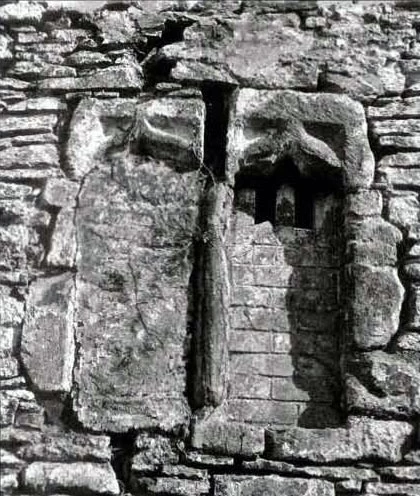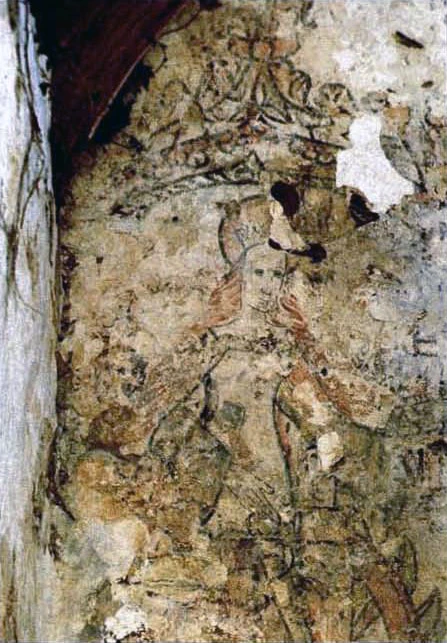A medieval church moves to the Museum
St Teilo's Church, Llandeilo Tal-y-bont, in situ in 1984
Stone mullioned medieval window uncovered from beneath layers of lime wash and render during the dismantling process
Wall-painting of St Catherine, 'in situ', found on the east wall of the south transept, believed to have been painted c.1400
From Llandeilo Tal-y-bont to Cardiff
St Teilo's church was built during the 13th century. There was probably an earlier church on the site. Abandoned in the 1960s, it was scheduled as an Ancient Monument by Cadw: Welsh Historic Monuments in the 1980s. As the decaying church could not be saved at its original site, it was offered to the Museum in 1984 for dismantling and re-erecting at St Fagans.
As the careful process of dismantling the Church began, two amazing wall-paintings from the 15th and 16th centuries were discovered, as well as numerous texts and areas of decorative patterns. These were all carefully recorded, removed and conserved.
The delicate removal of layers of lime-wash from the surface of the wall-paintings provided vital clues to the date of the original building. The removal of mortar from the outside walls enabled any Victorian or later alterations to be filtered out. After dismantling, the foundations were excavated, uncovering further clues to the Church's construction.
The history of the Church
The first surviving church was probably a small building consisting of a nave and chancel, a pattern that was standard throughout Wales at this time, thought to be 13th to 14th century. The next addition would have been the north transept, with the south transept probably built shortly after, as both are of similar construction. These probably date from the 14th or early 15th century, which corresponds to the dating of a wall-painting on the east wall of the south transept.
An extension of the south transept to form an aisle probably occurred during the late 15th century, the old south wall being replaced by an arcade of two arches, with another two cutting into both transepts. The final addition was a porch leading to the south aisle.
Expanding congregations
The Museum decided to rebuild the Church as it could have appeared around 1510-30. Architectural clues from this period can be used to understand the social, religious and political framework within which the Church was constructed and furnished. This closely follows the extension of the south transept to form the south aisle, presumably to accommodate a larger congregation. This could fit in with the economic recovery in Wales, after the Welsh Tudor dynasty became Kings of England in the late 15th century. This brought a period of relative calm after long periods of political and social unrest - including civil war.
Various clues show the nature of worship during the period up to 1530. Most important of these are the pre-Reformation wall-paintings. They show themes from the life of Christ and many saints, including St Catherine and St Christopher. Corbel stones found in the masonry work of the chancel arch show that there were once a medieval rood screen and loft. Both the wall-paintings and the rood screen and loft would have been brightly painted.
The poor man's Bible
Wall-paintings in churches have been described as "the poor man's Bible". They were designed to show scenes from the Bible to a congregation unable to read or write. They were also painted to create a sense of awe, fear and obedience. In some cases, the wall-paintings like the ones found in St Teilo must have been the only means of communicating any religious message at all, as both reading the Bible and preaching were in Latin, which congregations did not understand.
An end to worship
The growing population of the area, the development of other larger churches and frequent acts of vandalism led to St Teilo's falling into disuse. These events reflect the social, religious and political history of the Church just as much as the pre-Reformation wall-paintings do. The re-erection of the Church at the Museum is but another phase in its history, where visitors in the 21st century will be just as valued as its medieval pilgrims! St Teilo's Church now has a good chance of surviving for many more years.



Comments - (1)